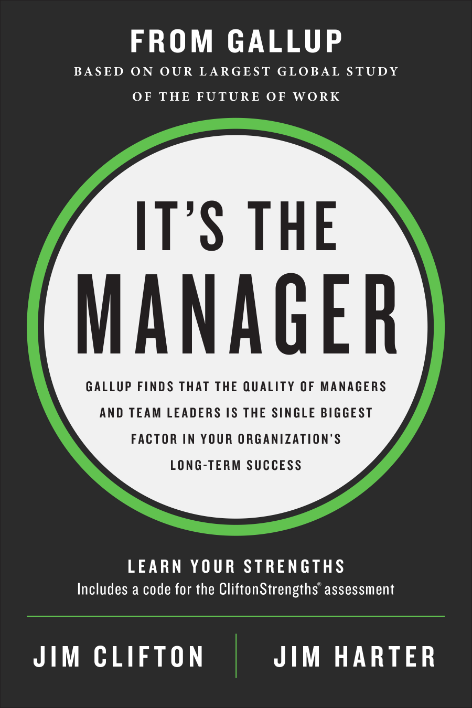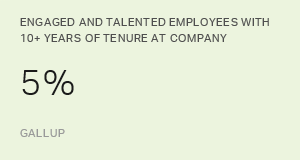Steve SaLoutos is an Executive Vice President at U.S. Bank. He was recently named Regional Executive of Midwestern Markets and he just performed an amazing hat trick.
In his previous role as head of Metropolitan Banking, where he oversaw more than 1,100 managers, he launched a new approach to talent that increased the number of top management talent candidates tenfold -- which included a higher percentage of diverse candidates -- without changing his recruitment strategy.
As SaLoutos explains to Paul Berg, Gallup Senior Managing Consultant, in the following conversation, U.S. Bank achieved this feat by using talent analytics at the beginning of the applicant journey, not the middle.
This small shift made huge changes in U.S. Bank's current talent pool, especially in the number of diverse candidates.
According to SaLoutos, the positive effects are rippling through all his branches -- and eventually, up to senior leadership as well.
Berg: Steve, you've made talent-based hiring a key part of your strategy for well over a decade now. What led to that decision?
SaLoutos: We started using Gallup for talent assessments probably 15 years ago. It gives us a more objective assessment of individual talent than we get from our own interviewing, even though we have very experienced managers doing the hiring process.
Berg: Why is that?
SaLoutos: Managers tend to focus more on the banking attributes of the employee as opposed to the raw talent and leadership we're looking to select. We all know that banking can be learned, but the talent aspect, the leadership aspects, really are innate and can't be learned.
It's important for us to find the right people and teach them banking, as opposed to trying to bring out talents that they just don't have.
An individual can be a very strong banker, that's who they are and that's fine, it just doesn't mean they're going to be the best in a management or leadership role. Everyone has unique strengths, and everybody can use their strengths in different ways.
It's important for us to understand which strengths are in which candidates so we'll know which individuals will be able to work well within our environment and be successful here. What we've found using Gallup's tools is that if we hire talented people who align with our needs, we will be more successful in the end.
"What we've found using Gallup's tools is that if we hire talented people who align with our needs, we will be more successful in the end."
We see that coming through in critical measures like customer experience, revenue growth, the sales management aspects of the job.
That does not mean a candidate won't be successful at a different bank, but we've built a profile based upon people who are successful at U.S. Bank. With our culture. With our way of doing business. And we're trying to identify more people like that.
Berg: You had a fork in the road moment a few years back. Tell me a little about that.
SaLoutos: Prior to having Gallup do the [digital] assessment for us, we realized we were effectively screening out candidates. We were trying to guess at who would be an "A" or "B" candidate.
As a result, we didn't know who we were leaving behind in the selection process. We needed to expand the funnel. So, we moved to an electronic assessment, which Gallup developed for us, with the idea that we could assess 10 people to find the one candidate as opposed to interview 10 and try to get the one or two to take the assessment.
Effectively, we were assessing people earlier in the process, which was a very different approach. Gallup's [digital] assessment is a more efficient way of talking to people and it gave us more candidates to choose from and a broader distribution of As, Bs and Cs.
So we, therefore, identified many more As. We didn't do this with the expectation that it would result in a more diverse candidate pool, but it did.
That was a significant win.
Berg: That's huge.
SaLoutos: We spent a lot of time training on diversity and inclusion, we spent a lot of time on the fact that people have biases that they don't know that they have.
We do an unconscious bias training session for all our senior leadership. And the reality is it's true. Bias happens.
We found ourselves screening out individuals who should be candidates before they got a chance to take the assessment. And lo and behold, if you give everyone who's qualified to be a bank manager the assessment, you get a more diverse candidate pool and a greater talent match, too.
It was a wonderful outcome that came from moving the assessment to earlier in the hiring process.
"And lo and behold, if you give everyone who's qualified to be a bank manager the assessment, you get a more diverse candidate pool and a greater talent match, too."
Berg: I want to get back to something you mentioned earlier -- before you changed the hiring process, you had experienced leaders who had done a lot of hiring, Gallup created interview guides, best practice guides, we did in-person trainings, we joined your meetings, we did phone trainings.
And yet, only about one-third of the time you'd find an "A" candidate. Or even less frequently than that. Talk about why you think that was the case.
SaLoutos: I think that's one of the paradoxes of this whole exercise. We had hoped and expected that our managers would be better at identifying "A" talent because they have been through the process with multiple hires.
But, by the same token, most managers don't have that much hiring to do. Our turnover rate for managers is well below 20%, so even a district manager who has, say, 18 branches, is unlikely to do more than three hires in a year. They just aren't in practice and we're not trained psychologists, we're bankers.
So, we tend to look at people we know -- often our internal candidates, or people who have a banking background -- because we can talk banking with them. We're not necessarily the best at determining who's going to be the strongest leader, who's going to be able to motivate, who's the most customer-focused, who has the talent to create the environment where others are successful.
We tended to stay within our comfort zone, which was bankers who have done this before. You get tied up in the banker as opposed to the leader side of hiring. What Gallup has allowed us to do is to choose, once again, talent first and then think about banking skill. You can teach banking skill, but you can't teach talent.
"You can teach banking skill, but you can't teach talent."
That was, I think, a surprise. We thought we could do it on our own so that 90% of the people we send to Gallup would get an "A" assessment [result]. That did not prove to be the case at all. Now having said that, we have some managers who are remarkably good at selecting talent.
One woman who works for me in Ohio said she could probably pick the As out of any pile of resumes, and that after one conversation, she knew their Gallup "grade." It's like she could go work for Gallup, she was that good.
But we didn't have enough like her. We'll never have enough like her.
Berg: That's a rare talent, even at Gallup. But in management, what do "A" managers do that others don't?
SaLoutos: I think the biggest difference is the "A" managers view the entire team as an orchestra they're conducting. They get more value by being the conductor than they do by doing the work themselves.
A [low-talent] branch manager who gets overwhelmed with the task at hand and starts to do everything him- or herself, has a team that will gladly say, 'Go ahead and do it, and we'll sit back and watch you do it.' That is a destructive environment for the manager, they burn out.
It's destructive for the customer because they don't get the attention they need. Destructive for the staff because they're not getting the development they need.
Low talent managers create destructive environments -- for themselves, their teams and customers.
To me that's the biggest difference -- an "A" leader will focus on being an excellent leader, not just being an excellent producer. They view their role much more as a leader as opposed to a doer. And that's what we need.
We need someone who will think holistically about the benefit to the customer, how they bring people along, how they grow individuals to excel.
To be a leader, you have to have followers. And the followers get to choose whether they're going to follow you or not. There are intangibles that come with managing and leading people. Therefore, it's important for us to identify someone who will truly be a leader of people who work for us and, honestly, a leader for customers as well.
You see plenty of quotes about how a great boss at a bad company is better than a bad boss in a good company. Obviously, our goal is to have a great boss at a great company. We do that by being more selective of our managers.
We look at several different factors when evaluating the success of a manager, but we believe that employees who are engaged will lead to greater customer experiences. In our branches, in our phone centers, in every part of the bank. Engaged employees are the foundation.
How do you get engaged employees? You have a great leader helping them understand engagement and how they can have a mutually beneficial career helping customers, but also helping themselves move forward. Engagement is a critical part of leadership.
Berg: How do you know this selective approach works?
SaLoutos: It shows up in the metrics. It shows up in turnover. It shows up in customer experience scores, which we track on a daily basis. It shows up in the productivity of the office.
Branches with great managers sell more. Their balance sheet and income statements grow. "A" talent excels at all of those measures and their staff has better discussions with customers, and those customers tend to do more business with us.
It's all intertwined, and it starts with acquiring the right talent at the manager level who brings the team along with them. One of the best compliments you can give to a manager of a branch is, 'You're able to influence people you don't control.'
Our business model, and it's worked very, very well for us, is to co-locate two to five partners -- sometimes in wealth management, business banking, mortgage, maybe our payment solutions team members -- in a branch location.
They share the financial hierarchy, they're part of the balance sheet, but they don't work for the branch manager. So the manager has to lead those individuals through influence, because even though the manager doesn't have management control over them, those partners contribute greatly to the customer experience. In the customers' eyes, those partners are integral parts of their banking experience.
It's important that we have the right leader to deliver that holistic customer experience. Customers don't care how we're organized, they care about the banking services they need to achieve their goals in life.
Berg: Your metrics show how talent turns that customer experience into business because it makes for deeper relationships with customers. How do managers actually do that?
SaLoutos: I think it starts with the fact that we are fundamentally a relationship bank. Everything we do is based upon enhancing our relationships with customers. We ask great questions and then make thoughtful recommendations to the customer based upon their needs.
It's not about me selling my product today, it's about us having a conversation to understand your needs. There may or may not be a product or service that helps you, but our job is to give you thoughtful, comprehensive recommendations to help you achieve your goals in life.
"It's important that we have the right leader to deliver that holistic customer experience. Customers don't care how we're organized, they care about the banking services they need to achieve their goals in life."
To do that well, we have to deliver the whole bank, all of our services and capabilities, to the customer. Our people have to be well-versed in all our products and services, so we spend a lot of time training our staff to understand them. But we also train them on how to ask those great questions.
Managers and leaders who engage their people create a workforce that wants to have the conversations customers need. As opposed to making U.S. Bank a convenience store for bank transactions.
Berg: In this changing banking environment, with customers visiting the branch less often, how important is the role of the branch and the branch manager?
SaLoutos: Transaction volumes in branches are down, and that's a good thing because a transaction at a branch that a customer can do digitally has little value for customers or us. Taking time out of your day and going to the bank is a cost to customers. Fewer visits allow us more opportunities to do the things that can truly create value for the customer.
If you deposit a check on your phone but come in to talk about that home you want to purchase, or that new car you want to buy for your kid, the 529 plan you want to set up -- those bigger, more important conversations for most families -- we can create more value for you.
Quite honestly, we create more value for the bank as well. We're actually encouraging customers to think about all the digital tools available for routine, transactional activities. As a result, customers save their time and focus on the big things that they need to have a great conversation with a trained, qualified banker about.
Berg: Speaking of conversations, how does the bank handle development conversations with those talented managers?
SaLoutos: [In my former role as head of Metropolitan Banking] I had about 1,100 branches that rolled up to me and we used CliftonStrengths with all of them. We want to make sure we understand how you use an individual's strengths to help manage them and help them be successful managers for others.
"You see plenty of quotes about how a great boss at a bad company is better than a bad boss in a good company. Obviously, our goal is to have a great boss at a great company."
And part of that is making sure we just have great conversations about their strengths. So, for example, I have mentoring conversations with about 10 managers a year, and the first thing I say is, 'Tell me your strengths. We're going to talk about how you use your strengths to be successful at your job.'
We've used Gallup's more intense coaching programs to teach many of our performance managers to be better strengths coaches for our branch managers and our district manager workforce to make sure they understand, don't try to bend something that's not going to bend.
Be who you are and use those strengths to be successful. Really focus on how you use those to achieve our business objectives.
Berg: A bit ago you mentioned the "paradox of this whole exercise." Has anything about this journey really surprised you?
SaLoutos: Our ability to hire a more diverse talent pool.
I think we are pretty good when it comes to diversity at the branch manager level, we are not as good yet [as we want to be] at higher levels.
But we're a unique company. It's difficult to come in at a high level in this company, you have to kind of be raised here, especially in the branch network.
So, therefore, having a more diverse senior leadership team [in the future] starts with the people we hire as branch managers today. By taking those blinders off, that we didn't know we had, that were not intentional in any way, shape, or form, we have a more diverse candidate pool.
We're really pleased with increasing the number of talented managers; hiring talented people makes us more successful.
But also increasing our diversity, too -- meeting a long-term strategy and a really important U.S. Bank objective, that is a significant win. To me, that's one of the true benefits of the change to the digital assessments and assessing more people.
This is one of three articles in a series about U.S. Bank's success with talent analytics. Read more about how analytics-based hiring improved performance and diversity and about the return on your investment in CX.
Gallup can help you find and train the world's best managers:
- Learn more about our work in the financial services industry.
- Equip your managers to coach their teams based on their CliftonStrengths.
- Learn more about leading the people strategies of your organization by reading Gallup's new bestseller, It's the Manager.




